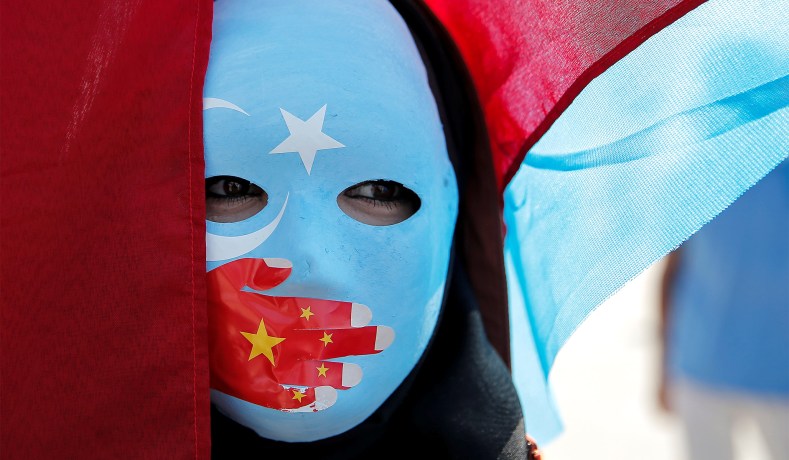
In the most comprehensive accounting of Beijing’s Xinjiang-related disinformation efforts to date, the Uyghur Human Rights Project, a Washington-based NGO, launched a report yesterday on how the Chinese Communist Party has worked to stall international action on its actions in the autonomous region, which a growing chorus of observers describes as a genocide.
Since 2017, Beijing has operated a network of detention facilities in China’s far West, interning what researchers say is upwards of one million Uighur Muslims. In addition to the camps, which Chinese officials describe as political “re-education” facilities, many perform forced labor for companies that sell materials to multinational corporations. The detainees are, according to reports, tortured, subjected to forced sterilizations, and, in some cases, killed. The situation in Xinjiang represents one of this century’s most widespread mass atrocities, and the CCP is covering it up.
When reports about the camps started to emerge a couple of years ago, Beijing neglected to comment on them. Eventually, though, it had to address the allegations, denying them for the first time in 2018. Starting later in the year, though, the CPP acknowledged the camps’ existence for the first time, arguing for their necessity as part of a campaign to root out terrorism and extremist activity in Xinjiang. Of course, the truth is that the detention drive is indiscriminate, sweeping up ordinary people. The evolution of this narrative has dovetailed with an increasing use of state propaganda instruments to push it. The name of the UHRP report, “’The Happiest Muslims in the World,’” comes from the CCP’s assertions that Uighurs are happy people who enjoy dancing — in other words, that Beijing has brought much-needed economic development, not egregious human-rights abuses.
Although Chinese diplomats in the West have in recent weeks further discredited their narrative, these missteps are only the most visible part of a highly sophisticated propaganda machine that has to a significant extent shielded Beijing from an international response. The emerging public awareness of the Xinjiang concentration camps can be credited to the painstaking work of dogged journalists and Uighurs who have risked great danger to speak out. The report discusses how family members of activist Uighurs who have fled are weaponized for blackmail and propaganda purposes.
In recent years, General Secretary Xi Jinping has worked to consolidate entities previously directed by the state under the CCP’s United Front Work Department, an agency that works to bolster the Party’s influence inside China and abroad. Bethany Allen-Ebrahimian, China reporter for Axios, noted during the panel discussion launching the UHRP report Tuesday that “in 2017 the party ate the state,” and that “what we are seeing in Xinjiang is really part of a larger pathology” as Xi consolidates his control over the Chinese party-state. Quoting CCP officials in Xinjiang, the report describes how Beijing views the Uighur mass-internment drive as part of an ideological struggle. This entails an element of influencing international perceptions of the situation in Xinjiang:
Since launching its narrative about its mass detentions in the XUAR in 2018, CCP officials and media have deployed accusations of “fake news” while defending the camp system both domestically and internationally, dismissing criticism as an anti-China conspiracy. Additionally, the Chinese government has invited diplomats, journalists, and scholars to visit East Turkistan, staging a select few internment camps to appear to be voluntary education centers. The Chinese government claims that its methods have eradicated separatism and religious extremism in the region, despite the lack of credible evidence to prove that there was ever substantial extremism in the XUAR.
The upshot is that the range of instruments and methods employed by Beijing to spread disinformation have swayed journalists and governments to accept its claims. According to the report, foreign journalists and government officials have been shown some of the facilities on tightly-controlled tours since 2019, leading some to come away with the conclusion that the camps are more-or-less benign. The authors discuss how officials remove watchtowers and razor wire ahead of these visits to make the camps appear less menacing. And in addition to cultivating Beijing-friendly reporters around the globe, officials will place op-eds in foreign newspapers to promote the narrative. CCP officials have denied the Xinjiang human-rights abuses in articles published by the Jakarta Post and other outlets.
This manifests itself in diplomatic support for the mass-detention program. When a group of 22 countries at the U.N. Human Rights Council condemned it, China responded with a letter backed by 50 countries defending Beijing’s actions. During the UHRP panel discussion, Freedom House’s Sarah Cook described how the disinformation campaign was designed to give cover to governments supportive of Beijing’s actions. Even in authoritarian Gulf States, such as Bahrain and Qatar, some officials have spoken out about Xinjiang, but they are quickly silenced, failing to move the needle on government policy. Support for the Xinjiang camps also correlates strongly with participation in the Belt and Road Initiative, Beijing’s massive infrastructure project stretching across the Eurasian landmass.
The CCP’s Xinjiang narrative has virtually never been accepted in Western democracies, except by some fringe voices. Softer condemnations have grown louder, and the U.S. government recently imposed sanctions targeting the officials involved in the most egregious abuses. But to neutralize the disinformation campaign described in the report, these governments should make it impossible for China’s partners to deny that a genocide is in motion, actively combating Beijing’s disinformation about Xinjiang and placing the issue at the top of the agenda. It hasn’t been there in the past.







